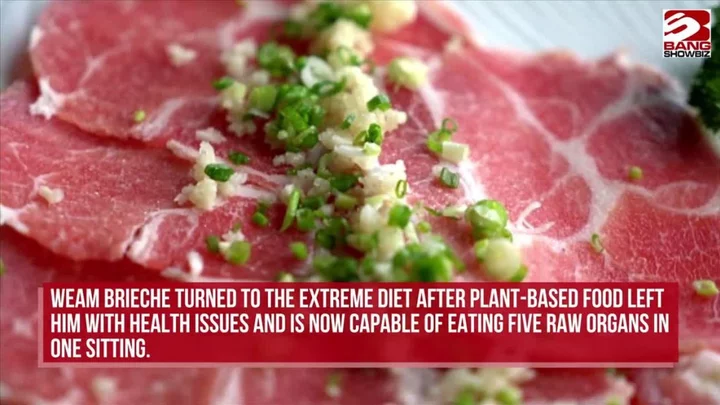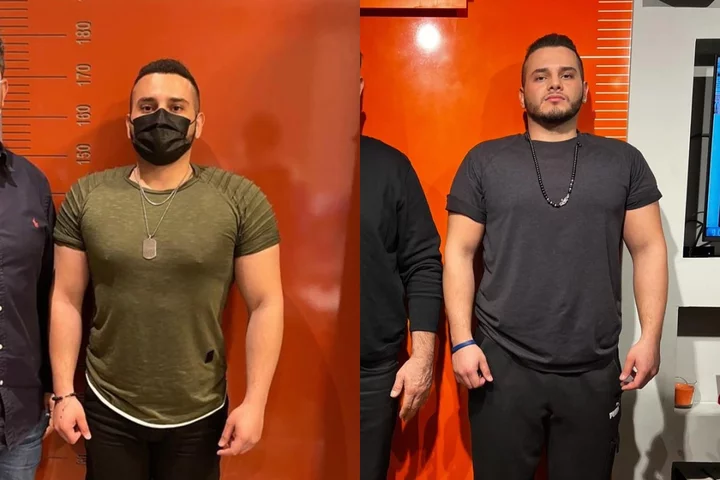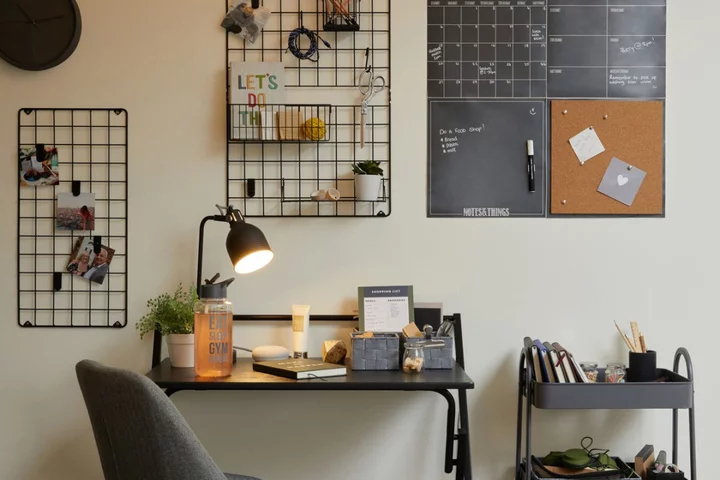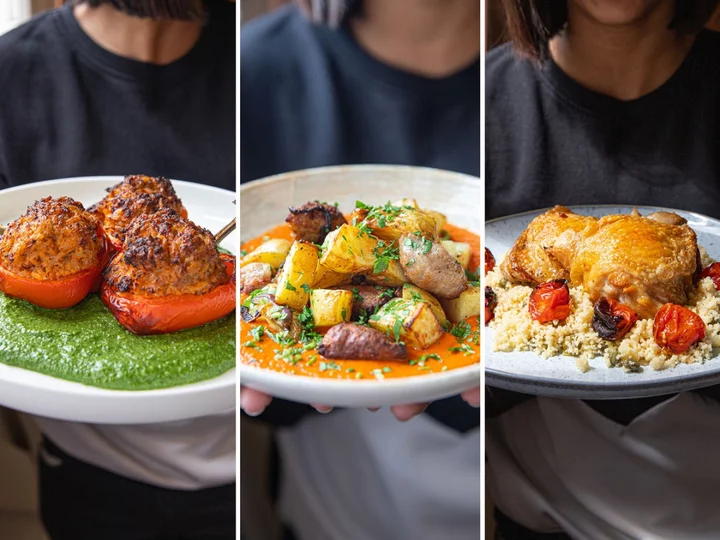
As Simon Cowell shares positive therapy experience, how can it help even if you aren’t in crisis?
X Factor boss Simon Cowell, 63, has shared that having discovered therapy in the past year, he feels as though “a weight has lifted off my shoulders”. The music mogul, who is behind The X Factor and Britain’s Got Talent, said he wished he had seen a therapist “10 or 20 years ago” in a recent interview with the Daily Mirror. He also shared that the deaths of his parents and the coronavirus pandemic had affected his mental health. Seeking therapy has been transformative for Cowell and it could do the same for you, whether you are in crisis, or just want to learn more about yourself. Cowell has said engaging in therapy had a “super positive effect” on his life and encouraged others to do the same, so here’s what you should know. There are different types of therapy Contrary to what many people may believe, counselling, where you sit and talk through events and reflect, is not the only form of therapy. “There are a whole host of different types of therapies available, from counselling, cognitive behavioural therapy, mindfulness-based cognitive therapy, acceptance and commitment therapy, interpersonal therapy, psychodynamic psychotherapy to eye movement desensitization and reprocessing,” explains psychologist and author of The Self-Care Revolution, Suzy Reading.Each one can have a different role in helping you get to know yourself better, handling trauma, feeling more grounded and coping more day-to-day. Therapy isn’t just for rock bottom Therapy doesn’t have to be a last resort. “When it comes to therapy, there are no hard and fast rules,” says Liz Ritchie, a St Andrew’s Healthcare psychotherapist. “Many people associate seeking help with crisis, but there is no reason why you cannot maintain regular sessions with your therapist. There is now a wealth of evidence that supports that therapy can also be a preventative form of mental healthcare, a little bit like going to a dentist or a doctor. “Life is busy and stressful, which means we don’t often have time to process cross words with a loved one, work altercations or issues with friends and family members.” You’ll understand yourself better You may think you understand yourself totally, but there are always new parts of ourselves to get to know. “Therapy helps us better understand ourselves, our relationships and the world, connecting us with how we feel, and why we might feel as we do. It is a journey of self-discovery, helping us appreciate our strengths and identify our values,” says Reading. It could give you an emotional toolkitIt can be helpful to have “an impartial sounding board to speak openly and honestly and the opportunity to be heard, validated and understood”, says Reading. “Therapy helps us challenge unhelpful thoughts, dispute self-limiting beliefs and can help us create new habits. Therapy is also about developing healthy ways to move through our emotions, creating a fresh toolkit of coping strategies and can be very practical in nature by helping us address specific challenges or goals.” But… it isn’t easy Unfortunately getting therapy is not always easy. If you do not have the financial freedom to be able to pay for a private therapist, you may be faced with long waiting lists and restrictive services. However, NHS therapy is an option and can be really helpful, so be sure to look into the options you can afford near you. Reading recommends checking out BPS and HCPC to find a qualified therapist. NHS resources can be accessed here. If you are seriously struggling with your mental health, and are at risk, please call 999 or the Samaritans on 116 123.
2023-08-31 20:51

Clergy dish up meatball sundaes, pickle ice pops and a little faith at the Minnesota State Fair
Faith has a deep-rooted presence at the Minnesota State Fair, from the decades-old Lutheran and Methodist dining halls to an evangelical chapel handing out thousands of free Bibles to a booth seeking to combat misinformation about Islam
2023-08-31 20:29

Former vegan claims he hasn't been sick after switching to raw meat diet
A 20-year-old man from Sweden has switched out his vegan diet for raw meat with claims he has "never gotten sick." Jones Hussain, who transformed his diet “in the name of health,” opened up about his decision after watching the late American alternative food nutritionist, Aajonus Vonderplanitz, whose “Primal Diet” has inspired people worldwide. He now enjoys raw chicken, cuts of beef, minced meat and fish – even if they are brown or smell slightly. He also implements fruit and juiced veggies into his diet. Health has always been important to Hussain, who said he would not eat a slice of cake for £10,000 because of the sugar. He claims to have not had a slice since the age of 13. “If any food safety expert looked at the food I eat, I think they would have a heart attack because the beef is sometimes brown, the liver looks green, the chicken stinks,” Hussain told PA Real Life. “But I eat that and then nothing happens. I did the experiments on myself to see whether what we have been led to believe is actually true and surprise, surprise, it wasn’t.” Hussain, who said he has always been driven by “health”, came across the raw meat diet plan in 2019 a few months after quitting veganism. “My starting point has always been health,” he said. “So I’ve experimented with a bunch of things in the name of health.” The diet was designed by Vonderplanitz, who touted the benefits of eating raw foods, in particular meat and dairy. “I found one of his lectures on YouTube and started listening,” he said. “At first, I was just as shocked as anyone would be to see someone eat such a diet.” But Hussain said he found Vonderplanitz’s arguments to be “honest and convincing” and so decided to give it a try. “I ate raw meat for the first time in November 2019 and I felt great,” he said. “It was just a straight cut of raw beef.” Having not fallen ill, Hussain then decided to try raw ground beef. “That was the scary part because that’s when you enter into uncharted territory,” he said. “I was like, if I get sick then I won’t do this anymore. Lo and behold, again, I didn’t get sick, so I started eating raw ground beef because it’s much cheaper than straight cuts.” To start with, Hussain would flavour the raw meat with spices and garlic. “But then I felt that I didn’t need them, even from a taste perspective,” he said. “So I just started consuming it by itself and ever since then I’ve eaten raw ground beef almost every day.” By the summer of 2020, Hussain had become accustomed to eating all types of meat. “I had no problems eating raw chicken because I had found a fairly good source in the supermarket so I ate it like KFC,” he said. “I also started buying raw liver here and there, and eating a small amount every day.” The raw meat Hussain kept in his fridge soon started to turn “green”, but this did not stop him from eating it. “Since I was so convinced about what Aajonus was saying, I was not worried and just consumed it,” he said. “But if there was any white mould, then I got rid of the batch, although this did not happen very often.” Hussain has continued eating raw meat ever since, although his family prefers ground beef to chicken because of the smell. “Nowadays I don’t so much eat raw chicken because it stinks up the house,” he said. In a single sitting, Hussain said he is capable of consuming around 400g of raw liver. He said he believes dumping veganism for raw meat has improved his gut health and helped get rid of his acne. “The thing with raw meat is that the nutrients are more easily absorbed and unaltered,” he claimed. “It’s not that raw meat has some kind of special superpower, it’s just that by not cooking it, I get more nutrients and no byproducts.” NHS guidelines, however, state that “cooking meat properly” kills harmful bacteria which can cause food poisoning. Hussain had been a vegan for two years, from 2017 to 2019, before eventually converting to the primal diet. “It’s not that I was struggling to get enough nutrients,” he said. “It’s that a human being cannot survive on a vegan diet successfully. “Of course, you can take supplements but it’s not the same thing, because they are processed. “There is no other way of getting these nutrients naturally other than by eating animal products. “So veganism on that basis, falls on its face.” Hussain also eats raw fish such as salmon and tuna and said he is happy to eat any type of meat provided he can find a reliable supplier. The Primal Diet also includes fruit and vegetables, all of which are consumed raw. “I eat cucumbers and tomatoes, as well as oranges and apples when they are available to me,” he said. “The philosophy is don’t cook the food, but there is a variety.” 'Hussain’ unusual diet often shocks people, including his parents who are concerned for his wellbeing. He explained: “Usually people have the same reaction, at first they think what the hell is this guy doing? He’s going to die in a few days. “Then they speak to me and find out that I’ve been doing it for three and half years, that I’ve never gotten sick, that my arguments are logical and that I look healthy. “They are like all right, that’s a new perspective that I had not heard before.” People behave differently on social media, however, said Hussain, who has his own YouTube channel, Excellent Health. He also works part-time at an elderly day care centre and has written a book titled The 6 Health Commandments. “The only time I ever got food poisoning was from a frozen bag of raspberries before I started eating meat,” he said. “I decided not to act out of fear, but to see what is true and what isn’t true.” To find out more about food safety, visit www.food.gov.uk/safety-hygiene/cooking-your-food. Sign up for our free Indy100 weekly newsletter Have your say in our news democracy. Click the upvote icon at the top of the page to help raise this article through the indy100 rankings.
2023-08-31 18:30

Terminally ill mum wants ‘happy memories’ with family after hand numbness turned out to be deadly disease
A mum who was told she likely suffered from carpal tunnel syndrome after feeling numbness in her right hand during her pregnancy has been given just a few years to live after scans revealed she will soon be paralysed. Charlotte Parker, 28, from West Berkshire, was diagnosed with amyotrophic lateral sclerosis (ALS) nine months after giving birth and is now trying to create “happy memories” with her young family while there is still time. The rare condition, a type of motor neurone disease (MND), means Charlotte only has two to five years’ life expectancy during which time she will become increasingly paralysed. Charlotte, who lives in Thatcham with her fiance George, 32, a mechanic, and their three children, says she wants her 11-month-old son Jimmy to know she was there. Her friends and family are fundraising so she can afford to take her family to Disneyland in Paris and take advantage of what time they have left together. “I don’t think you can imagine having to tell your parents at 28 that you have been diagnosed with a terminal illness,” Charlotte, who works as a revenue and debt accountant at an energy company, told PA Real Life. “At the moment my life is so fast paced that I don’t really have much time to slow down and think about what’s happening. “Most people think MND-ALS affects older people but it actually affects a wide range of people. It can happen to anyone.” Charlotte was seven months’ pregnant when she began feeling a strange “numbness and weakness” in her right hand. “I was struggling to open jars and bottles,” she said. “Gradually it just got worse and worse and by the time I gave birth to Jimmy, I was considerably weaker. “Doing day-to-day tasks while trying to learn how to look after a newborn baby was definitely a challenge.” After flagging the numbness to her midwife, Charlotte was told she likely suffered from carpal tunnel syndrome, a common health condition caused by pressure on a nerve in the wrist. But Charlotte was referred to a neurologist when she went for a routine checkup six weeks after Jimmy was born. “He sent me for an MRI in January for possible inflammation in the brain,” she said. “I think subconsciously at the time that’s when I knew it was something a bit more serious.” While Charlotte was worried, her results came back and suggested there was no problem with her brain or spinal cord. Instead of getting better, however, the numbness started to spread to her other hand. “I kept calling because it started going into my left hand as well,” she said. “I am still able to move my fingers in my left hand but my right hand does not really work anymore.” In June, Charlotte was given an electromyography, a medical test which looks at how a person’s nerves and muscles respond to stimulation. “They put stickers on you and send pulses up your arm,” she said. “I got called in to see the neurologist quite quickly after that, which is when he advised that he strongly believed that it was MND-ALS.” I want to do as many days out with the children as possible so that we have those memories all together. Charlotte Parker ALS, the most common motor neurone disease, is incurable and causes progressive weakness and paralysis, usually leading to death within three to five years, the National Institute of Neurological Disorders and Stroke said. Charlotte’s worst fears were confirmed after she visited John Radcliffe Hospital in Oxford in July and was formally diagnosed. “It’s been a lot to adjust to, especially with a four(-year-old), seven(-year old) and eleven-month-old,” she said. “To know that there is no cure or treatment that will give me a substantial lease of life. “It is just going to deteriorate pretty quickly.” Charlotte broke the devastating news to her family and friends that her illness is terminal. “My youngest is completely none the wiser and the girls are aware that my hands are getting weaker and that it will move to my legs, but we haven’t gone into the detail of what it means will happen.” Unfortunately, doctors are unable to say how quickly Charlotte’s condition is progressing. “Each person’s story is different,” she said. “It’s such a maze on how one person’s body deteriorates to the next.” But Charlotte is not letting the diagnosis get in the way of her family plans. The mum, who does not have life insurance, plans on continuing to work for “as long as possible”. “I am fortunate that my work provides death in service,” she said. “If I can, I will try and work for as long as possible so that my partner and children do have something to help them for the next however many years.” She also plans on marrying the “love of her life”, George, after getting engaged two years ago and falling pregnant. “I fell pregnant and it just got pushed to the side. I didn’t want to get married nine months’ pregnant,” she said. “It’s time for us to celebrate us as a couple rather than just accepting that we’re not going to be together for the rest of our lives. “We have to make good of what we can and celebrate what we do have, right now, rather than just accepting the situation.” The couple, who recently went on holiday to Pembrokeshire, are also looking to create “happy memories” while there is still time. “We were on the beach late evening, when it was raining and full of wind, and we were taking photos running in and out of the sea to make memories,” she said. “I want to do as many days out with the children as possible so that we have those memories all together. “Even silly things, like being there for Jimmy’s first haircut and taking him to feed the ducks so that we can capture those memories and that he knows that I was there.” Charlotte’s friends have set up a fundraiser on GoFundMe to help them cover their costs, including a trip to Disneyland, Paris. “It would be a great trip to have with them,” she said. “I just want to enjoy my family and do as much as I can with them because there will come a point where even though I’m around, it will be a lot more complicated.” They have so far raised £11,235 of their £15,000 target. Charlotte continued: “A huge thank you to anyone who can help and it will go to creating some of the best memories I can with my family before the inevitable does happen.” To support Charlotte, visit: www.gofundme.com/f/complete-her-wishes-with-her-family Read More Woman’s blood cancer misdiagnosed as carpal tunnel due to burning hand pain What happens to your brain when you’re pregnant? Cyclist completes 960-mile ride to remember friends who died from MND What is sickle cell disease and how do you know if you have it? Project launched to bust myth that cancer is a ‘white person’s disease’ Man who lengthened his limbs by three inches says he feels ‘so much happier’
2023-08-31 17:53

Project launched to bust myth that cancer is a ‘white person’s disease’
More must be done to get black, Asian and ethnic minority people to participate in breast cancer trials, experts have said, as they warned that people from these backgrounds have been under-represented in previous studies. Medics said that they want research into the disease to be “relevant to people we see in the clinic”. Experts said that there is a “broad misperception” that black women “don’t suffer as much from breast cancer” which can result in the perception that “cancer is a white person’s disease”. If I hadn’t gone on the trial at The Christie, I wouldn’t be here today Jasmin David This is despite the fact that previous studies have found that black women are more likely to die from breast cancer compared to their white peers. They are also more likely to develop more aggressive cancer and be diagnosed when their cancer is at a more advanced stage. It comes as the NHS Race and Health Observatory launched a new campaign alongside Macmillan Cancer Support to improve diversity in breast cancer clinical trials. The project, which is being supported by Roche, aims to raise awareness of the lack of diversity in clinical studies, improve communications and provide longer term support to patients. Specialist nurses will be provided at two major cancer hubs – Bart’s Health NHS Trust in London and The Christie NHS Foundation Trust in Manchester – to help guide patients through the process. Men, who account for 1% of breast cancer patients in the UK, are also being included. The NHS Race and Health Observatory said that there are “multiple barriers” around the recruitment, communication and retention of black, Asian and ethnic minority patients in clinical trials. It said that data show that people from an ethnic minority background are poorly under-represented in many clinical trials. And the Caribbean African Health Network said that there has been a “disengagement” in research “as a result of mistrust”. Jasmin David, a 53-year-old breast cancer patient from Fallowfield in south Manchester, took part in a clinical trial which saved her life and is encouraging others to do the same. Two years after her initial diagnosis and treatment at The Christie she was told that the cancer had come back and had spread to her lungs, lymph nodes and chest bone. The mother-of-two was told she had less than a year to live but was also offered the opportunity to take part in a clinical trial at the National Institute for Health and Care Research Manchester Clinical Research Facility. Ms David is now cancer-free. “If I hadn’t gone on the trial at The Christie, I wouldn’t be here today,” she said. “I have two children and now I get to be there for them as they grow up. “Research gave me a second chance and life and I’m relishing every second of it. “I want everyone, no matter their ethnicity, to have equal access to clinical trials, so I’m glad that this important piece of work is being done. I hope that by sharing my story I can inspire more women like me to come forward and take part in clinical trials.” Dr Habib Naqvi, chief executive of the NHS Race and Health Observatory, said: “We are pleased to announce this partnership and our joint commitment to ensuring inclusion and representation in future breast cancer trials. “We believe that when targeted, culturally sensitive interventions and communications are put in place, under-represented groups can be successfully recruited into clinical trials.” He added: “There is a broad misperception that black women don’t suffer as much from breast cancer or it does not run in their family history. This can result in the perception that cancer is a white person’s disease. “We want this pilot to encourage women at risk, those already diagnosed and individuals undergoing post treatment to come forward and share their experiences and get the information needed.” Professor Richard Simcock, chief medical officer at Macmillan Cancer Support, added: “As a Breast Cancer Oncologist I want to know that research is relevant to the people we see in clinic. Historically that has not been the case. “I’m delighted that Macmillan can support this project to ensure that future evidence from clinical trials is representative and inclusive.” Charles Kwaku-Odoi, chief executive of the Caribbean African Health Network, said: “Across the black community there is an undoubted legacy of disengagement in research and most certainly clinical trials that stems back decades as a result of mistrust. “This has not served us well because it leads to a lack of appropriate interventions that perpetuate the grave health inequalities in breast cancer care. “This partnership approach to build solutions to improve engagement in clinical trials in breast cancer treatment and care is very much welcomed. We are looking forward to working in a collaborative way to build trust, improve awareness and ensure that barriers surrounding access to clinical trials are addressed.” Read More Charity boss speaks out over ‘traumatic’ encounter with royal aide Ukraine war’s heaviest fight rages in east - follow live 10 slick ways to kit out your student digs 4 essential officecore trends to update your work wardrobe Sickle Cell Awareness Month: What is sickle cell disease and how do you know if you have it?
2023-08-31 17:25

Man who lengthened his limbs by three inches feels ‘so much happier’
A Canadian man has had limb-lengthening surgery, costing £25,000, to increase his height from 5ft 7in to 5ft 10in as he was so insecure about his height it caused him to have “suicidal thoughts”, and claims he is now “so much happier” and “confident”. Daniel Farbod, 27, a civil engineer, from Toronto, Canada, has been self-conscious of his height “all (his) life” – when he stopped growing, at age 14, he said it felt “tragic” and like his “first stab to the heart.” Daniel always defined “being masculine” as being tall, and was “ashamed” of himself as he “didn’t feel like a man.” Over time, being taller was all Daniel could dream about, and claimed his height “impacted his mental health so badly” that he was having “suicidal thoughts”. After coming across the unique surgery online, he realised he was “willing to sacrifice time and money to get (his) life back.” So, in May 2021, he had his first procedure in a specialist clinic in Turkey, which involved breaking his femurs, hollowing out the bone, and putting a rod inside the bone with external fixators, pieces of steel on the outside of his legs. Daniel had to turn the fixators with an Allen key every day for over four months, and eventually had his second surgery to remove the fixators after his bones had successfully fused together. When Daniel recovered, he could not “put into words how happy (he) was” and “felt so much more confident”, now, he is sharing his journey on social media to inspire others who are insecure about their height. Daniel told PA Real Life: “I’m really proud of myself for having the surgery. “I was insecure all my life about my height, it impacted my mental health so badly. “I was suicidal, and after admitting that I wanted to take the steps to feel better, and have the surgery, I feel so much better. “I think for other people, it is important to know how tough the surgery and recovery is – it was the hardest thing I’ve ever done, but for me, it changed my life and made me grow not only literally but also metaphorically as a person.” Daniel, who has always been self-conscious about his height, stopped growing at age 14, and became obsessed with finding ways to become taller. He said: “I researched everything from socks and supplements that claimed to increase your height. “I was always insecure and worried about it – I used to go to orthopaedic doctors because I was so scared of not growing. “But when I got to age 14, I stopped and it was so depressing.” When it became clear to Daniel that he was unlikely to grow any more, it took a toll on his mental health and confidence. He explained: “It was so tragic for me, it was like my first stab to the heart. “All my dreams would be about being taller and I had to somehow accept that my height had peaked. “I tried to keep myself busy to manage my thoughts but in 2020 I just couldn’t handle it – I had all of these negative thoughts and suicidal thoughts because I think being masculine, and being a man, means to be tall. “I didn’t feel like a man, I was so ashamed.” Daniel felt as though having limb-lengthening surgery was the only way he was going to feel better, but his parents, who are both “on the shorter side”, did not approve of his decision to have cosmetic surgery. He said: “Everyone was really against the idea because they thought it was not natural and it was changing the way your body is meant to be. “I knew the surgery was going to be tough, but I thought even that pain would be better than having suicidal thoughts. “I was willing to sacrifice time and money to get my life back.” In May 2021, Daniel had his first surgery in a specialist clinic, Live Life Taller, in Turkey, which involved breaking both of his femurs, hollowing out the bone, and putting a rod inside the bone with external fixators – pieces of steel on the outside of his legs. He explained: “I was really scared when I got to the clinic, and the breaking of the bones was the part I was most nervous about in the whole process. “It was crazy to wake up after the surgery – the reality just hit me all at once and I was so happy.” His recovery involved being in a wheelchair and using an Allen key to turn a bolt on the fixators four times a day at 90 degrees to separate the bone segments a little at a time. Daniel continued to do this every day for four and a half months, saying of his painful recovery: “My skin was stretching, my muscles were growing, it was madness. “It took me even longer to recover, they usually say it will take three months, but, my I had nerve issues with my right leg and had to have it broken again. “It was a very tough time.” In September 2021, the external fixators were removed, he explained: “I used a walker and really really slowly I worked up to using crutches. “I couldn’t really tell how tall I was at that point. “It took me at least another three months to be able to stand up.” Mr Farbod went from 5 ft 7 to 5ft 10 and thinks his mental health has dramatically improved as a result. He said: “I couldn’t believe it. I had been dreaming of being a tall man since I was 10 years old, it’s all I’ve ever wanted. “I went through all these sleepless nights, trauma and upset, and I finally achieved my goal. “I can’t even put into words how happy I was, and still am – I felt so much more confident.” When Mr Farbod arrived home, his family were also very happy for him. He said: “They looked after me so much – I could barely get out of bed or bend down for a long time. “They could tell I was so much happier when I recovered.” Now, Daniel shares his journey on Instagram and YouTube to inspire others who are insecure about their height. He said: “I want to show people the reality of the surgery – it’s tough but I want to raise awareness and get men talking about their insecurities.” For support, contact the Samaritans on 116 123, email them at jo@samaritans.org, or visit samaritans.org to find your nearest branch. Read More Charity boss speaks out over ‘traumatic’ encounter with royal aide Ukraine war’s heaviest fight rages in east - follow live 10 slick ways to kit out your student digs 4 essential officecore trends to update your work wardrobe Sickle Cell Awareness Month: What is sickle cell disease and how do you know if you have it?
2023-08-31 16:48

Cathay Expects to Suspend Hong Kong Flights as Typhoon Nears
Cathay Pacific Airways Ltd. expects to suspend flights starting Friday afternoon through Saturday morning in Hong Kong as
2023-08-31 15:59

10 slick ways to kit out your student digs
A new term and exciting times! But before the academic year kicks off, you’ve already been tasked your first assignment – how best to style-up your student space. Depending on your halls of residence and budget, you may have crowdfunded some of the basics from family and friends – and then you’ll want a few niceties to kit out your digs and personalise your pad. To take your bijou bedroom to the next level, we’ve done our homework and prepped some key pieces… 1. Linen and PU A4 Spiral Notebook – Brown, £3.49, Linen and PU A5 Notebook with Pen – Brown, £3.49, Linen and PU A5 Notebook – Grey, £2.49, Pack of 2 Linen and PU Pen Set, £2.99, Linen and PU Pencil Case – £2.99, rest of items from a selection, The Range Some might say stylish stationery is the foundation for formulating all those creative ideas. 2. Erica Green Ceramic Desk & Table Lamp, £45, Oliver Bonas Lighting is key to late-night swotting, especially when the clocks go back and you’re hoping to file an assignment ahead of time. With a trendy exposed bulb, geometric design and pink cord, this one’s bang up to date. 3. Pegboard – Medium, Pink, £50, Block When you need to picture something in your mind or are in need of inspiration, a mood board is where it’s at. Available in a rainbow of colours, these peg boards are right on point. 4. The Positive Student Planner, £24, The Positive Planner Described as a ‘dedicated student wellbeing planner’, this 12-week journal is geared towards helping with the pressure and stress of life as a student. Developed with mental health charity Samaritans, think mindful activities, tools and diary notes to keep you on track – and in control. 5. Wire Peg Board With Accessories, Black, £20, Grey 3 Tier Metal Trolley, £22, folding desk from a selection, Dunelm If you prefer the industrial look and a peg board made out of steel is more your thing, this one comes with hooks, baskets and mini shelves. Team with the sturdy trolley and add wire baskets to store your stuff. 6. Bronx Microwave, £85, Next An everyday essential, this charcoal grey model with timber handle and dial knob has the edge for those quick and easy ready meals. 7. Bronx Bottle Opener, £12, Next And when it’s time for a beer break, this groovy bottle opener is just the job. 8. ProCook Carbon Steel Wok, 26.5cm, £14, ProCook There’s more to a wok than stir-fries and this wonderful multitasking tool loves to steam, shallow-fry, poach, stew and toss. 9. Hebe Veronica Plant in Stone Pot, £8, Rowen Low-maintenance and looks good, what’s not to love about this fun faux foliage? 10. Single Green Bedding Starter Pack, £14, Dunelm A bedding bundle is a no-brainer when it’s time to get your head down. Read More Charity boss speaks out over ‘traumatic’ encounter with royal aide Ukraine war’s heaviest fight rages in east - follow live 4 essential officecore trends to update your work wardrobe Sickle Cell Awareness Month: What is sickle cell disease and how do you know if you have it? TikTok has gone wild for adult gymnastics – here’s what you should know
2023-08-31 15:26

4 essential officecore trends to update your work wardrobe
Taking inspiration from the Noughties, ‘officecore’ is all about embracing traditional workwear in a modern way. Big on TikTok, the nine-to-five trend focuses on relaxed tailoring and preppy pieces that look cool whether you work in an office or not. And with that ‘back to school’ feeling in the air, now is the perfect time to refresh your work wardrobe. Here are four officecore ideas to shop this season… 1. Beige tailoring After kicking logomania to the curb, the quiet luxury trend is going nowhere, and that means a pale palette from day to night. Swap your usual black blazer for a two-piece co-ord in a soft shade like beige, biscuit, oatmeal or caramel. Add gold hoop earrings and a tonal leather tote to complete your laidback luxe look. Topshop Brushed Blazer Coat in Oat, £69.70 (was £82); Mini Skirt in Oatmeal, £30.60 (was £36), ASOS (accessories, stylist’s own) Fanfare Ethically Made Beige Linen Suit Jacket, £189 2. Pleated trousers Slim-cut Noughties trousers aren’t part of the officecore agenda (you may be pleased to here). Pleated wide-leg styles are the must-have of the season – perfect for pairing with crisp cotton shirts now, and rollneck tops as the weather turns cooler. Choose from extra-long ‘puddle pants’ that reach the floor, or ankle-length hems to show off your footwear. Paisie Teal Pleated High Waist Trousers, £95; Dark Green Knitted Cut Out Sleeve Top, £78 (top available in October) Misirli 1951 Tie Belt Anthracite Metallic Pants, £164.57 (were £274.28) 3. Pinstripe pieces The heritage print – fine chalky lines on a dark background – has had a major comeback lately in the form of minimalist separates you can mix and match. Try a waistcoat and trousers co-ord or a pinstripe shirt teamed with a high-waisted skirt. Threadbare Women’s Charcoal Pinstripe Lined Fitted Tailored Waistcoat, £39; Women’s Charcoal Pinstripe Wide Leg Tailored Trousers, £43 (shoes, stylist’s own) Fig & Basil Long Sleeve Pinstripe Shirt, £32; PU Ruched Midi Skirt, £40; V by Very Wide Fit Block Heel Slouch Knee Boot With Wider Fitting Calf, £45, Very 4. Luxe loafers Nothing says ‘back to school’ style like a pair of shiny shoes, and this season’s chunky metallic loafers are the ultimate statement footwear. Inspired by brands like Prada and Bally, next-level loafers in gold, silver and bronze shades are a key officecore piece. Oliver Bonas Crackled Copper Leather Loafer Shoes, £89.50 River Island Silver Chain Detail Loafers, £25 Dune London Gradual Loafers in Silver, £110, Debenhams
2023-08-31 15:23

Sickle Cell Awareness Month: What is sickle cell disease and how do you know if you have it?
Almost 300 babies are born in the UK with sickle cells every year, according to the Sickle Cell Society, and the effects of sickle cell disease are believed to impact thousands. Yet, many people may not even know what sickle cells are or what living with the condition means. What is sickle cell disease? In most people, red blood cells are disc shaped and move easily through the blood vessels. But if you have sickle cell disease, your red blood cells are shaped like a sickle (similar to a crescent moon). This stops them moving with ease through the body and blood flow becomes restricted. Sickle cell disease isn’t actually one specific disease – it refers to a group of conditions affecting people with sickle cells, which range in severity.The conditions are inherited and predominantly affect people from African and Caribbean family backgrounds. What are the symptoms of sickle cell disease? Symptoms begin early in childhood and can sometimes be debilitating. How each individual is affected may vary, but the main symptoms are anaemia, an increased risk of infections, and pain. This includes extremely painful episodes called ‘sickle cell crisis’, which happens when blood flow to certain parts of the body become blocked. According to the NHS, these episodes can last for days and require hospitalisation. Other issues are associated with the condition too, including problems with the lungs, delayed growth in childhood, higher risk of stroke, leg ulcers and sight/vision problems.How is it diagnosed? Sickle cell disease is usually picked up during pregnancy or shortly after birth, although a blood test can be given at any time to see if someone has the condition or carries sickle cell genes. In parts of the country, pregnant people will be offered a test to see what the chances are of their child having sickle cells. Infants can be checked for the cells through a heel prick test.How do you treat it? Treating sickle cell disease is usually a lifelong process to help people with pain and to stay as healthy as possible. Treatment takes place in specific sickle cell centres and those living with it are encouraged to take care of their health, no matter the severity of their symptoms. Managing pain is a huge part of treating sickle cell disease. Staying hydrated can be helpful, as well as avoiding sudden temperature changes, like getting into a cold shower or diving into water. According to the NHS, Hydroxycarbamide (hydroxyurea) may be recommended, which is taken as a pill once a day. This can lower the quantity of other blood cells and requires careful monitoring, however. Some people may also be able to have a medicine called crizanlizumab, either on its own or alongside hydroxycarbamide, usually injected into a vein every four weeks. To prevent infections, many people with sickle cell disease will take daily antibiotics. Read More Charity boss speaks out over ‘traumatic’ encounter with royal aide Ukraine war’s heaviest fight rages in east - follow live TikTok has gone wild for adult gymnastics – here’s what you should know Man explains why he swapped veganism for raw meat diet: ‘I feel great’ Rugby star Ugo Monye: Boarding school shaped my career and my personality
2023-08-31 14:49

Still not sold on air fryers? Let these recipes prove their worth
We’re all sick of hearing about them by now, but air fryers are still enjoying “a moment”. They can also really help reduce the time and energy it takes to make a dish, so we’ve teamed up with the culinary geniuses at Sorted and used this piece of magical kit to cook up three dishes that use it in three different ways. From deeply savoury cheesy sausage-stuffed peppers with vibrant spinach pesto, to hearty and comforting potato and sausage hash with a smoky tomato sauce, these recipes not only showcase the versatility and convenience of air fryers, they’re also pretty damn delicious. Not to forget the crispy chicken thighs and tomatoes with lemon, caper and almond couscous, which demonstrates the art of achieving both crispiness and succulence without the oil. Go forth and revolutionise. Cheesy sausage-stuffed peppers with spinach pesto We use red peppers in this recipe, but if you can’t find them, use any colour of bell pepper to your liking. Serves: 2 Ingredients: 3 red bell peppers 4 tbsp olive oil 250g microwave brown rice 120g cream cheese 1 tbsp tomato purée/tomato paste 4 pork sausages 100g cheddar 200g fresh spinach 30g almond flakes 1 clove garlic 15g fresh parsley 1 lemon Method: 1. Preheat the air fryer: preheat the air fryer to 200C. 2. Prep the peppers: cut 3 bell peppers in half lengthways and scoop out all the seeds from their centres. Rub the peppers with 4 tbsp of olive oil on the board and season with salt. 3. Assemble the filling: crumble 250g of cooked brown rice into a large mixing bowl. Add 120g of cream cheese and 1 tbsp of tomato paste, then coarsely grate in 25g of the cheddar - we will use the rest later. Squeeze in the meat from the casings of 4 sausages. 4. Mix it up: season with salt and pepper, then fold everything together, ensuring the sausage meat breaks up and is well dispersed through the mix. 5. Fill the peppers: divide the mix between the oiled pepper cups - there is no need to press and compact the mixture into the peppers. 6. Fry: pop the pepper halves in the draw of the air fryer, filling side up, and cook for 17-20 minutes until golden in places and piping hot throughout. When cut into, the sausage shouldn’t be pink. Get on with the rest of the dish in the next steps while you wait. 7. Get the spinach ready: add 200g of spinach to another mixing bowl and cover with cling film. 8. Cook the spinach: microwave on full power for 3-4 minutes, until darkened and wilted. 9. Assemble the pesto: once the spinach is ready, add 30g of almond flakes, 1 peeled garlic clove and 15g of parsley to the bowl. Coarsely grate in the remaining 75g of cheddar, then finely grate in the zest from 1 lemon, and squeeze in its juice. 10. Blend it up: blitz everything together with a hand blender, until smooth. Season to taste with salt and pepper. If you are still waiting for the peppers, now would be a great time to crack on with a bit of washing up. 11. Serve: divide the pesto between plates and spread it out to form discs. Top with 3 pepper halves per portion and tuck in. Potato and sausage hash with smoky tomato sauce This recipe can be vegetarian-ised by using veggie sausages instead! Serves: 2 Ingredients: 600g loose white potatoes 1 red onion 4 pork sausages 4 tbsp olive oil 4 cloves garlic 1 tbsp smoked paprika 400g tinned chopped tomatoes 15g fresh parsley 45g cream cheese Method: 1. Preheat: preheat the air fryer to 200C. 2. Prep the potatoes and onions: Cut 600g of potatoes into bite-sized chunks, then halve, peel and roughly slice 1 red onion. Add the veg to a large mixing bowl. 3. Add the sausage: squeeze the meat from the casings of 4 sausages into the bowl, creating little meatballs as you pinch them off. 4. Oil and toss: toss everything with 2 tbsp of the oil and a generous pinch of salt. Remember to wash your hands after handling raw meat. 5. Fry: tip the oiled potatoes, onions, and sausage balls in the draw of the air fryer and cook for 20-25 minutes, until golden in places and the potatoes are soft throughout. Give everything a toss halfway through cooking to ensure an even colouring. Get on with the rest of the dish in the next steps while you wait. 6. Prep the garlic: peel and mince 4 cloves of garlic. Add them to a medium saucepan along with the remaining 2 tbsp of olive oil. 7. Fry: place the pan over a medium heat and slowly fry for 2-3 minutes, until the garlic starts to colour. 8. Add the paprika: add 1 tbsp of smoked paprika and fry for a further 20-30 seconds, until very fragrant. 9. Add the tomatoes: add 1 400g tin of chopped tomatoes to the pan along with a generous pinch of salt. 10. Simmer down: simmer for 6-8 minutes, until reduced by S. Get on with the rest of the dish in the next steps while you wait. 11. Chop the parsley: finely chop 15g of parsley, then crack on with a bit of washing up while you wait for the sauce. 12. Blend: once the tomatoes have reduced by S, add 45g of cream cheese and blitz until smooth with a hand blender. 13. Serve: divide the sauce between plates and top with the fried potato, onion, and sausage. Scatter over the chopped parsley and serve. Air fryer crispy chicken thighs and tomatoes with lemon, caper and almond couscous If you aren’t into capers, you can leave them out or replace them with green olives. Serves: 2 Ingredients: 4 chicken thighs, bone-in, skin-on 200g cherry tomatoes 3 tbsp olive oil 150g couscous 2 tbsp capers 20g almond flakes 1 lemon Method: 1. Preheat: preheat the air fryer to 200C. Fill the kettle with water and put it on to boil - this will be for the couscous later. 2. Oil and season: add 4 chicken thighs to a large mixing bowl along with 200g of tomatoes. Toss with 2 tbsp of the olive oil and a generous pinch of salt, ensure everything is fully coated. 3. Get ready to cook: add the tomatoes and chicken to the tray of the air fryer. Ensure the chicken thighs are positioned on top of the tomatoes, skin-side up. 4. Cook: cook for 20-25 minutes, until the chicken’s skin is crispy and the tomatoes are soft and jammy. Get on with the rest of the dish in the next steps while you wait. 5. Assemble the couscous: add 100g of couscous, 2 tbsp of capers, 15g of the almond flakes, the remaining 1 tbsp of oil and a generous pinch of salt to another large mixing bowl. 6. Add the water: add enough boiling water from the kettle to just cover the grains, then give everything a quick stir. 7. Cook the couscous: set aside to cook the couscous for 6-8 minutes, until the grains are soft and have absorbed all the water. Crack on with a bit of washing up while you wait. 8. Finish the couscous: once the couscous is ready, finely grate over the zest from 1 lemon and squeeze in its juice. Fluff the grains with a fork and fold everything together. 9. Serve: divide the couscous between plates and top with the tomatoes and chicken. Scatter over the remaining 5g of almond flakes and serve. Find out more about Sorted and their nifty meal-planning app Sidekick at sortedfood.com/sidekick. Read More The dish that defines me: Evelin Eros’s rum cake ‘It started with a radish’: Chef Simon Rogan reflects on restaurant L’Enclume at 20 The true story – and murky history – of Portuguese piri piri oil ‘My depression stopped me doing what I loved most in life – cooking’ What Bake Off’s Jurgen Krauss really thinks of his shock elimination How to pull off a traditional German babka chocolate braid
2023-08-31 13:45

Some US airports strive to make flying more inclusive for those with dementia
With over 14 million people expected to check into airports nationwide for Labor Day weekend, a number of them inevitably will be travelers with dementia or some sort of cognitive impairment
2023-08-31 12:48
